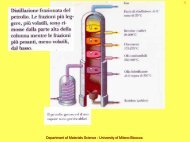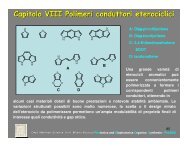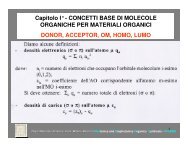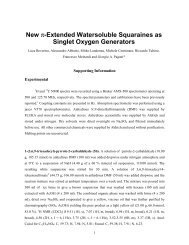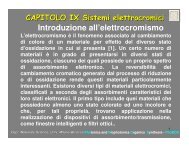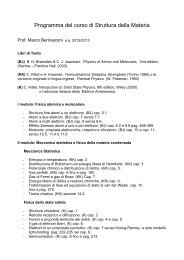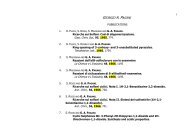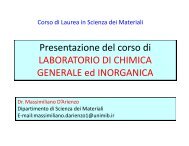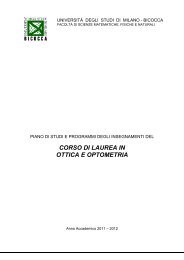Gonioscopic Evaluation of the Anterior Chamber Angle
Gonioscopic Evaluation of the Anterior Chamber Angle
Gonioscopic Evaluation of the Anterior Chamber Angle
You also want an ePaper? Increase the reach of your titles
YUMPU automatically turns print PDFs into web optimized ePapers that Google loves.
<strong>Gonioscopic</strong> <strong>Evaluation</strong> <strong>of</strong> <strong>the</strong><br />
<strong>Anterior</strong> <strong>Chamber</strong> <strong>Angle</strong><br />
University <strong>of</strong> Milan Bicocca<br />
June 2010<br />
Anthony Cavallerano, O.D.<br />
VA Boston Health Care System<br />
Draft Only<br />
The New England College <strong>of</strong> Optometry<br />
Boston Massachusetts<br />
anthony.cavallerano@va.gov<br />
cavalleranot@neco.edu
GONIOSCOPY<br />
• Gonioscopy is a technique that allows<br />
visualization <strong>of</strong> <strong>the</strong> anterior chamber angle<br />
structures and is used to diagnose abnormalities<br />
<strong>of</strong> <strong>the</strong> anterior segment, in particular <strong>the</strong><br />
anterior chamber angle structures.<br />
Draft Only
Gonioscopy - Indications<br />
• Glaucoma<br />
– Open angle<br />
– Narrow angle<br />
– Pigmentary/PXF<br />
– Neovascular<br />
• Post Trauma<br />
• Suspiciously marrow angle prior to dilation<br />
Draft Only
Draft Only
KOEPPE GONIOSCOPY<br />
• Convex lens is placed on anes<strong>the</strong>tized cornea<br />
• Hand held focal illuminator/patient in supine position<br />
• Wide angle view <strong>of</strong> chamber<br />
• Excellent impression <strong>of</strong> iris contour and angle approach<br />
• Low magnification/distorts <strong>the</strong> angle very slightly<br />
Draft Only
• Koeppe Lens<br />
– Direct Optical system<br />
Draft Only
Draft Only
Draft Only
Gonioscopy – Koeppe Lens<br />
Draft Only
INDIRECT GONIOSCOPY<br />
• Zeiss 4 mirror lens<br />
• Goldmann (Universal) mirror lens.<br />
• Slit lamp biomicroscope<br />
• Each quadrant examined indirectly by placing<br />
<strong>the</strong> mirror in <strong>the</strong> quadrant opposite <strong>the</strong> area<br />
to be examined<br />
Draft Only
• Zeiss 4 mirror lens<br />
– Indirect Optics<br />
Draft Only
Gonioscopy – Posner lenses<br />
Draft Only
Gonioscopy – Posner Placement<br />
Draft Only
Draft Only
Draft Only
Zeiss 4-mirror Zens<br />
• 4 mirrors positioned for gonioscopy<br />
• Central lens for <strong>the</strong> posterior pole<br />
• Smaller ocular surface Only<br />
• Precorneal tear film serves as <strong>the</strong> intervening fluid<br />
• Four angles viewed rapidly<br />
• Central lens provides adequate view <strong>of</strong> posterior<br />
pole Draft
Indirect Gonioscopy (Contemporary)<br />
Draft Only
Gonioscopy - Instrumentation<br />
Draft Only
Gonioscopy – Sussman Lens<br />
Draft Only
Universal Lens Placement<br />
Draft Only
<strong>Anterior</strong>-<strong>Chamber</strong> <strong>Angle</strong> Anatomy<br />
Draft Only
A/C <strong>Angle</strong> and Trabecular Drainage<br />
Draft Only
Indirect Gonioscopy (Contemporary)<br />
Draft Only
Gonioscopy - Instrumentation<br />
Draft Only
Universal/Goldmann Lens<br />
• Most commonly used gonioscopic technique<br />
• Lens eliminates internal reflection redirects image<br />
incorporated in <strong>the</strong> lens<br />
• Requires topical anes<strong>the</strong>tic and intervening fluid<br />
• Monitor corneal epi<strong>the</strong>lium<br />
Draft Only
Draft Only
Draft Only
Draft Only
Draft Only
Three Mirror Universal (Goldmann) Lens<br />
• Versatile lens<br />
• Larger, easier to handle<br />
• Additional mirrors/lenses<br />
– <strong>Gonioscopic</strong> mirror<br />
– Equatorial and peripheral mirrors<br />
– Central fundus lens for optic disc and macula<br />
Draft Only
Draft Only
Draft Only
EXAMINATION TECHNIQUES<br />
Goldmann (Univerdsal) lens<br />
• Align slit lamp for patient and examiner<br />
• Low magnification (10x)<br />
• Scan anterior portion <strong>of</strong> eye<br />
• Anes<strong>the</strong>tize cornea<br />
• Fill <strong>the</strong> meniscus <strong>of</strong> <strong>the</strong> lens, halfway with gonioscopic<br />
solution<br />
• Intervening fluid forms strong capillary bonds and allows<br />
moderate lens manipulation<br />
Draft Only
Draft Only
Draft Only
Draft Only
Draft Only
• Corneal ulcer<br />
Contraindications<br />
• Corneal abrasion<br />
• Blunt or penetrating injury<br />
• New/recent surgical wound<br />
Goldmann tonometry prior to<br />
gonioscopy<br />
Draft Only
Technique<br />
Insertion<br />
• Set up slit lamp (low mag., narrow beam, straight<br />
ahead)<br />
• Have patient look down, pull upper lid<br />
• Have patient to look up, pull lower lid<br />
• Place lower edge <strong>of</strong> lens in inferior cul-de- sac<br />
• Tilt lens forward against plane <strong>of</strong> cornea, let lower lid<br />
go<br />
Draft Only<br />
• Position/focus microscope into gonio mirror<br />
• Increase magnification to 16x<br />
• Lens in place - held by capillary action.<br />
– Balance lens without much pressure exerted to globe
Draft Only
Draft Only
Draft Only
Removal<br />
Technique<br />
• Break suction between lens and cornea<br />
• Irrigate eye with sterile saline<br />
• Clean lens with contact lens cleaning<br />
solution<br />
• Rinse well, air dry and store in container<br />
Draft Only
Draft Only
STRUCTURAL OVERVIEW TO<br />
UNDERSTANDING GONIOSCOPY<br />
PUPIL AND IRIS:<br />
• pupillary margin<br />
• Iris plane<br />
• Peripheral iris insertion<br />
Draft Only
Draft Only
Draft Only
Draft Only
Normal angle<br />
Draft Only
Grading<br />
4 structures = wide open<br />
3 structures<br />
2 questionable<br />
1 = occludable (Schwalbe’s line)<br />
Grading angles<br />
Draft Only<br />
Normal angle
Draft Only
Draft Only
CILIARY BODY (CBB)<br />
• Highly vascularized<br />
• <strong>Anterior</strong> iris stroma is continuous over<br />
anterior ciliary body<br />
• Irregular threadlike thickening <strong>of</strong> fibers, called<br />
iris processes branch, coalesce over anterior<br />
ciliary body<br />
• Do not cause increased IOP<br />
• Terminate at scleral spur but occasionally at<br />
Schwalbe's line.<br />
Draft Only
Draft Only
Draft Only
Draft Only
Draft Only
Scleral Spur<br />
• Easily seen in wide angle at <strong>the</strong> anterior end <strong>of</strong> <strong>the</strong><br />
angle recess where <strong>the</strong> ciliary body inserts.<br />
• Thin white line<br />
• Iris processes stop at this point<br />
• Easily visible when blood fills Schlemm's canal, or<br />
pigment deposited in <strong>the</strong> meshwork.<br />
Draft Only
Draft Only
Draft Only
SCHLEMM'S CANAL<br />
• Often appears as a gray zone just above scleral spur<br />
• More obvious when blood-filled<br />
Draft Only
Draft Only
TRABECULAR MESHWORK (TM)<br />
• Trabecular pigment band forms directly in front <strong>of</strong> <strong>the</strong><br />
Schlemm’s canal due to deposition <strong>of</strong> pigment <strong>of</strong> granules<br />
• Denser in pigmentation in brown iris patients than blue eyed<br />
patients<br />
• Band becomes less translucent and more opaque with age<br />
• Inferior angle becomes more pigmented<br />
Draft Only
Draft Only
Draft Only
SCHWALBE'S LINE<br />
• <strong>Anterior</strong> termination <strong>of</strong> Descemet's membrane<br />
• Represents <strong>the</strong> change in curvature between <strong>the</strong> flat<br />
sclera and steep cornea<br />
• A condensation <strong>of</strong> collagenous fibers which runs<br />
around <strong>the</strong> inner peripheral cornea<br />
• Marks <strong>the</strong> anterior insertion limit <strong>of</strong> <strong>the</strong> angle<br />
structures<br />
• Pigment may be deposited on Schwalbe's line<br />
Draft Only
Draft Only
Draft Only
Draft Only
SL<br />
TM<br />
Draft Only<br />
SS<br />
CBB
Abbreviations<br />
• CBB: Ciliary body band<br />
• TM: Trabecular meshwork<br />
• SS: Scleral spur<br />
• SL: Schwalbe’s line<br />
Draft Only
Recording<br />
• record <strong>the</strong> deepest structure visible in each <strong>of</strong> <strong>the</strong> four<br />
quadrants as shown below (most POSTERIOR structure)<br />
Draft Only<br />
OD OS
• Recording:<br />
OD OS<br />
Draft Only<br />
• Classification <strong>of</strong> angle width:
Draft Only
USE OF GONIOSCOPY<br />
1. Pre -dilation evaluation <strong>of</strong> potentially narrow angles<br />
2. <strong>Evaluation</strong> <strong>of</strong> all potential glaucoma conditions<br />
3. Narrow angle glaucoma<br />
4. Confirmation <strong>of</strong> Primary angle open glaucoma or chronic<br />
open angle glaucoma<br />
5. Secondary open angle glaucoma:<br />
examples:<br />
» Pigmentary dispersion<br />
» Ocular trauma: angle recession<br />
» Lens induced<br />
» Neovascular glaucoma<br />
6. Tumors <strong>of</strong> iris and ciliary body<br />
7. O<strong>the</strong>rs<br />
Draft Only
Slit Lamp Examination and<br />
• Intact cornea<br />
Tonometry<br />
• <strong>Angle</strong> estimation (temporarily or<br />
nasally)<br />
• Goldmann tonometry<br />
Draft Only
Draft Only
Draft Only
Draft Only
Draft Only
Draft Only
Draft Only
Draft Only
2. If angle on Van herick are less than 1/4: 1, use <strong>the</strong><br />
gonioscopy lens to evaluate <strong>the</strong> angle.<br />
Van herick:<br />
Width <strong>of</strong> cornea equal to 1<br />
(3/4, 1/2. 1/4, 1/8)<br />
Draft Only<br />
Width <strong>of</strong> shadow compare to<br />
width <strong>of</strong> cornea in fractions
Draft Only
Draft Only
Draft Only
Draft Only
3. What is considered a narrow versus open<br />
angle on gonioscopy<br />
OD OS<br />
Draft Only
Shadow Technique<br />
• Penlight technique: temporally<br />
• If iris is flat, total illumination<br />
• If iris is bowed, shadow forms<br />
Draft Only
Draft Only
Draft Only




